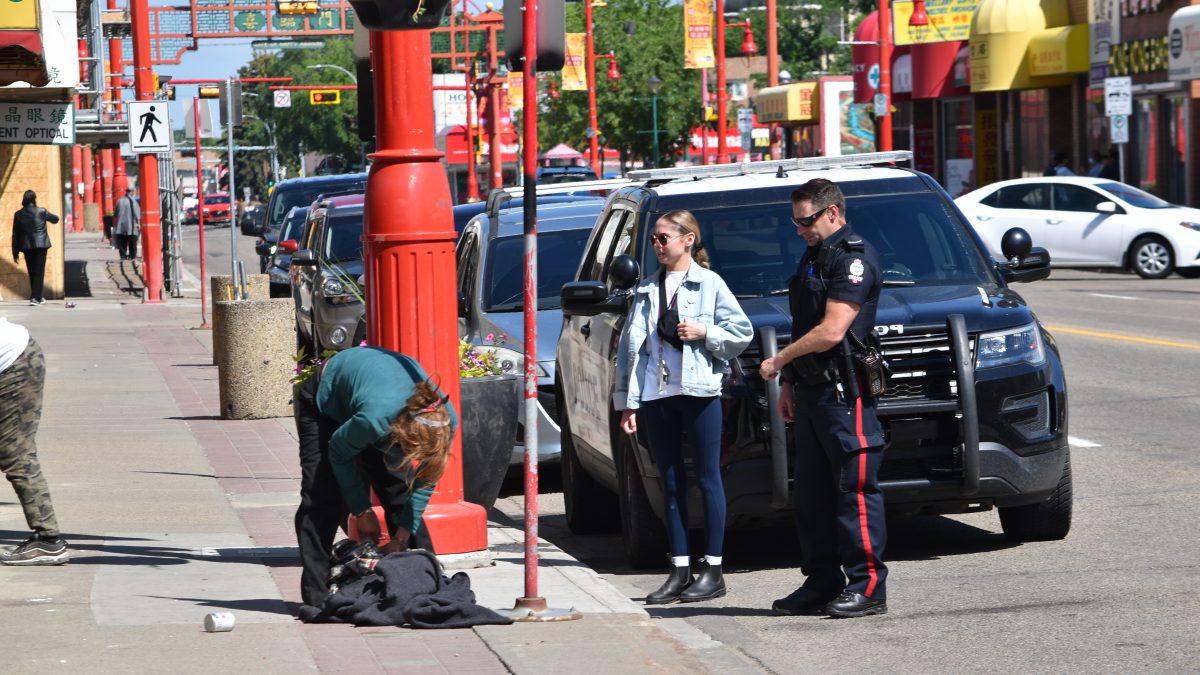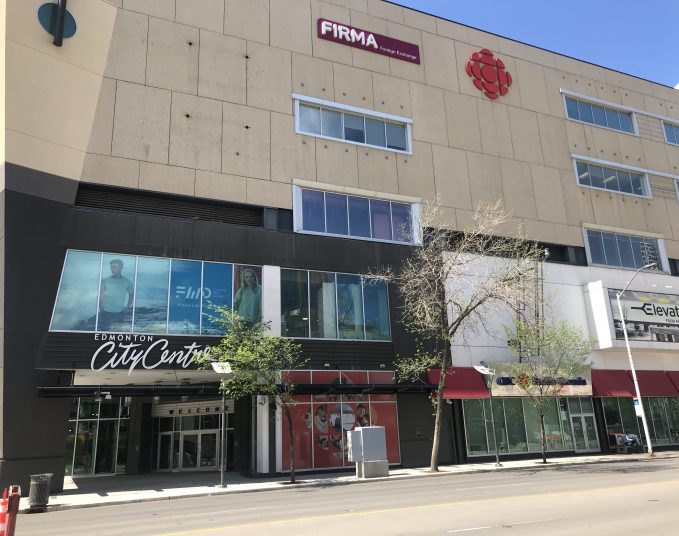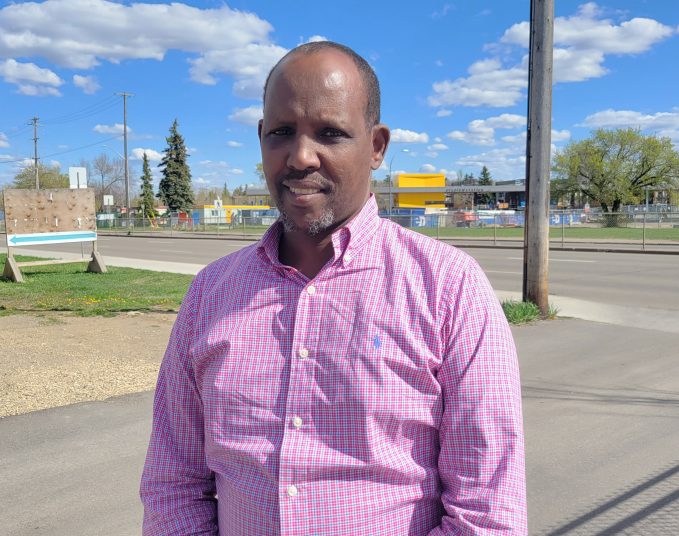On a sunny Thursday morning in May, just outside Edmonton City Hall, kids and young couples cool off in the wading pool, which is finally open again after a long closure for repairs. To the south, in Winston Churchill Square, pre-schoolers play with oversized chess and checkers boards meant to bring life to the open space, which is mostly empty. Off to the side, a Latin jazz trio plays for passersby.
A large young man in a dirty shirt and jeans approaches me and asks if I’m a teacher. “No, a journalist,” I say, feeling apprehensive. He stares blankly, then wanders off. A moment later I see him panhandle from a couple of men eating lunch on the steps. Nearby, a man sleeps in the shade, his head resting on his hardhat. Around me wander the homeless people, the addicted and the mentally ill.
The City of Edmonton recently approved a $407 million base budget for Edmonton Police Services for 2023, up from $378.6 million in 2019. The total EPS budget for 2022, including program funding, is $481 million, representing 13.5 per cent of all City expenditures.
In City Hall, the Edmonton Police Commission is meeting. It’s a packed house. Police Chief Dale McFee is reading a prepared statement about two recent slayings in Chinatown. Police have charged 36-year-old Justin Bone with second-degree murder in the deaths of Ban Phuc Hoang, 61, and Hung Trang, 64. At the time of the May 18 killings, Bone was on bail, the result of a previous break-and-enter charge. One of his bail conditions was that he live with an acquaintance in Alberta Beach and not enter Edmonton city limits, except in limited circumstances. But on May 16, that acquaintance, whom the Chief refers to as “the complainant,” called the RCMP to say Bone was erratic and he felt unsafe. The RCMP picked Bone up and dropped him near the intersection of Stony Plain Road and 156th Street. Two days later, Hoang and Trang were dead.
Family members of the two men and the wider Chinese community are up in arms. Shortly after the murders, EPS released a statement saying officers “interacted” with Bone in the days prior, and that he “was advised to abide by the balance of his ordered conditions, and to discuss any changes with his probation officer.” But in his statement at the Commission meeting, McFee says that information was incorrect. “The only contact EPS had was with the RCMP and the complainant who resided with Mr. Bone, on the telephone,” McFee says. “There was no interaction with Mr. Bone himself. To reiterate, officers did not make contact with Mr. Bone in the days prior to the homicides, as no offence had occurred, and there were no grounds to arrest or breach Mr. Bone.”
The tension at Commission meetings has ratcheted up recently, amid budgetary debates, the “defund the police” movement, rising crime, homelessness and addiction and, now, two deaths in Chinatown. And then there is the dysfunction within the Commission itself. At the May 18 meeting, Commissioner Jodi Calahoo-Stonehouse alleged that Anne Stevenson, also a commissioner and the City Councillor for much of downtown, was in a conflict of interest by employing a person who was a known critic of police. After that meeting, Commission Chair John McDougall expressed his own concern, saying the employee was “anti-police, anti-Chief McFee, anti-mayor and anti city-council.”
Then, in June, another Commissioner, Ashvin Singh, wrote to Mayor Amarjit Sohi to accuse Stevenson of interfering in a police investigation. Singh alleges Stevenson has “attempted on numerous occasions to actively influence an investigation of one of her close contacts, Duncan Kinney.” Kinney is the editor of Progress Alberta, a left-leaning news organization that has been critical of the Chief and the EPS. Singh alleges that Stevenson “not only contacted the Chief, but counsel to the Chief to attempt to accelerate or otherwise influence the outcome of that investigation.”
Kinney says he wasn’t aware of any investigation. In response, his lawyer, Tom Engel, sent a letter to Singh — shared with the media — asking to know more about the alleged investigation, about Stevenson’s attempts to influence it, and about the sources of his information.
Now added to this drama are the alleged murders of Ban Phuc Hoang and Hung Trang. As Chief McFee said at the end of his statement, “we must not forget, two lives have been lost. Our hearts continue to go out to the families of Mr. Hoang and Mr. Trang and the greater Chinese community.” At the same time, he tried to absolve the EPS, saying “our involvement was minimal.” He said the RCMP “granted permission” for Bone to be in Edmonton, and therefore “the EPS lost any ability to breach Mr. Bone for being in Edmonton.”
After the Chief finished reading his statement and had taken some questions from commissioners, the public was invited to the microphone. Seven people stepped up to express concerns about what was happening downtown, including Puneeta McBryan, the executive director of the Edmonton Downtown Business Association, who said the community has “experienced a retreat of EPS from downtown” and asked for more beat cops. Restaurant-owner James Burns also took to the microphone. He was trembling when his turn came up. His pizza place, Pazzo Pazzo, is a stone’s throw from City Hall. He said he’s worked downtown for 20 years, and he’s never seen it so bad. He’s been broken into several times, as have many of the surrounding businesses. “Do you guys enjoy looking outside?” he asked. “I’m disgusted with it. I don’t know what to do. It’s shameful.”
The RCMP is conducting an investigation into the decision to take Bone to Edmonton. No word yet on when that investigation will be completed.
Savvy AF. Blunt AF. Edmonton AF.




